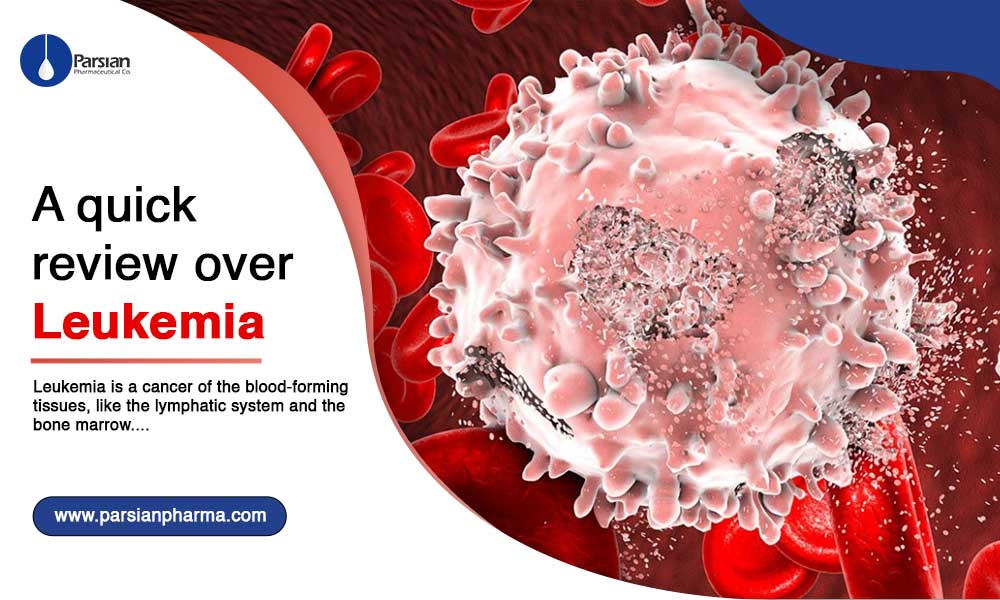A quick review over Leukemia
What is leukemia?
Leukemia is a cancer of the blood-forming tissues, like the lymphatic system and the bone marrow. There are several broad categories of blood cells, including white blood cells (WBCs), platelets and red blood cells (RBCs). Mostly, leukemia refers to cancers of the WBCs. It is characterized by a large rise in the numbers of white blood cells in the circulation or bone marrow. In patients with leukemia, an excessive amount of abnormal white blood cells, don’t function properly. Leukemia is accounted for 2.5% of overall cancer incidence and 3.5% of deaths from cancer in the U.S.
How does it form
In general, leukemia is thought to occur when some blood cells acquire changes (mutations) in their genetic material or DNA. When this happens, blood cell production becomes out of control, because the mutations tell the blood cells to continue growing and dividing. Over time, these abnormal cells can affect healthy blood cells in the bone marrow, leading to fewer healthy white blood cells, red blood cells and platelets, causing the signs and symptoms of leukemia.
Types of leukemia
Leukemia has four main types. It is subtyped by two ways, first it is according to how quickly has it started and the next one is about which type of cells are affected. It can be started by a sudden onset (Acute leukemia) or a slow onset (Chronic leukemia). In acute type, cancer cells multiply quickly and in chronic type, the disease progresses slowly and early symptoms may be very mild. According to type of cells which are affected, we have myeloid or myelogenous leukemia and lymphocytic leukemia. Myelogenous leukemia refers to abnormal cell growth in the marrow cells that mature into red blood cells, white blood cells, and platelets. In Lymphocytic leukemia, abnormal cell growth occurs in the marrow cells that become lymphocytes, a type of white blood cell that plays a role in the immune system.
There are four main classifications of leukemia:
- Acute myelogenous leukemia (AML)
- Acute lymphocytic leukemia (ALL)
- Chronic myelogenous leukemia (CML)
- Chronic lymphocytic leukemia (CLL)
The most common types in children are ALL and AML, and the most common types in adult are AML and CLL.
Acute myeloid leukemia (AML)
According to the National Cancer Institute (NCI), about 20,000 new AML cases are diagnosed each year in the U.S. This is the second most common type in children and one of the most common types in adults. The 5-year survival rate for AML is about 29.5%.
Acute lymphocytic leukemia (ALL)
According to the National Cancer Institute (NCI), about 6,000 new ALL cases are diagnosed annually. This is the most common type in children. In ALL, cancer can spread to your central nervous system and lymph nodes. Acute lymphocytic leukemia (ALL) is mostly seeing among children. The 5-year survival rate for ALL is about 69.9%.
Chronic myeloid leukemia (CML)
According to the National Cancer Institute (NCI), about 9,000 new cases of CML are diagnosed annually. With this type, you might not be diagnosed until you have a routine blood test and you might not have noticeable symptoms. Mostly CML is seeing among adult. People aged 65 and above have a higher risk of this type. The 5-year survival rate for CML is about 70.6%.
Chronic lymphocytic leukemia (CLL)
According to the National Cancer Institute (NCI), about 21,000 new CLL cases are diagnosed annually. This is the other most common type in adult. Some types of CLL will be stable for years and won’t need treatment. But with others, body isn’t able to create normal blood cells, and patient will need treatment. CLL is most likely to affect people aged 55 and above, it’s very rarely seen in children. The 5-year survival rate for CLL is about 87.2%.
| Prevalence of incidence | Child or adult type | 5-year survival rate | |
| AML | 20,000 | Both |
29.5% |
|
ALL |
6,000 | Children |
69.9% |
|
CML |
9,000 | Adult |
70.6% |
|
CLL |
21,000 | Adult |
87.2% |
And Hairy cell leukemia is a very rare subtype of CLL. Its name is because of the appearance of the cancerous lymphocytes under a microscope.
Staging
Leukemia should be staged once when it is diagnosed. Based on cancer staging, treatment team can find out how much cancer has progressed and spread and also determine patients outlook. AML and ALL can be staged based on cancer cell appearance under a microscope and the type of involved cells. And based on WBC count at the time of diagnosing, ALL and CLL can be staged. AML and CML are staged based on the presence of immature white blood cells or myeloblasts in the blood and bone marrow.
Assessing the progression
Determining the cancer progression can be done by some other tests:
- Determining cancer growth rate by examining of the DNA of the cancer cells with flow cytometry
- Determining whether cancer cells are affecting the liver or not by liver function tests.
- Determining whether cancer has spread to the central nervous system or not by lumbar puncture test.
- Determining any damage to other organs by imaging tests, such as X-rays, ultrasounds, and CT scans
Treatment options
Based on the type and stage of the cancer, and also patients overall health and other medical condition, the treatment team can choose the best among treatment options. Although some types grow slowly and do not need immediate treatment. However treatment usually is one or more of following: Radiation therapy, Stem cell transplantation, Biological or immune therapy and Targeted therapy which are now new class of interest for cancer due to the advantages efficacy, selectivity and safety by acting on specific targets involved in proliferation and differentiation of cancer cells with minimal activity on normal cells compared with traditional oncologic ones.
Some of the main references that Parsian pharma scientific section has observed them:



